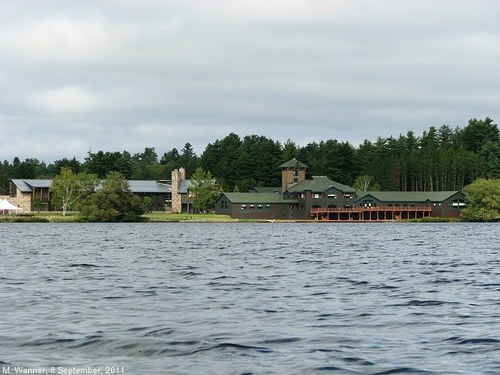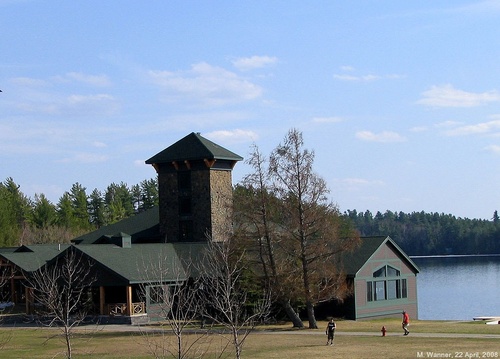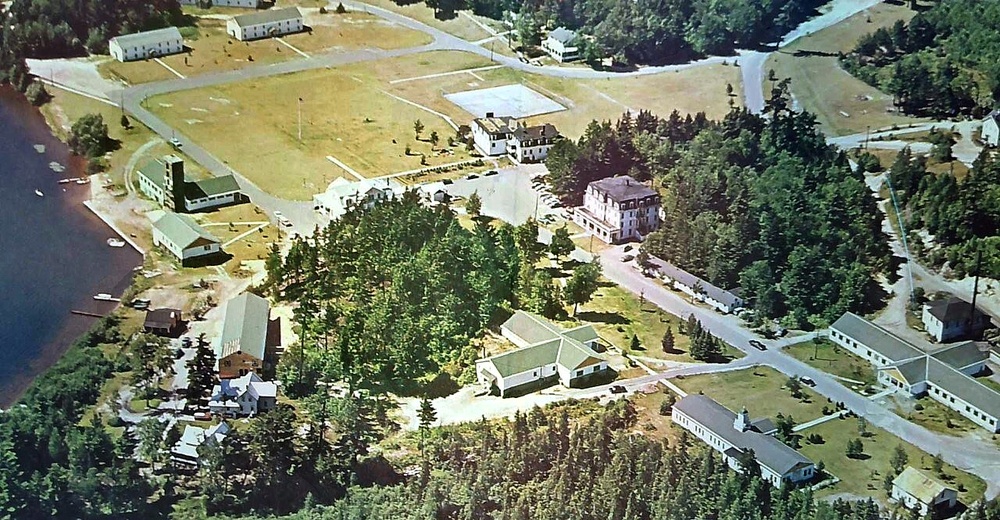 Paul Smiths College, from Lower St. Regis Lake Paul Smith's College is a private college that presently offers both two-year and four-year programs; its strongest programs are in hotel & restaurant management, culinary arts, natural resources, fisheries and wildlife science, forestry, recreation, biology, and business. The college was founded by a bequest of Phelps Smith, son of Paul Smith, whose Paul Smith's Hotel provided both the campus and the funds to establish the college.
Paul Smiths College, from Lower St. Regis Lake Paul Smith's College is a private college that presently offers both two-year and four-year programs; its strongest programs are in hotel & restaurant management, culinary arts, natural resources, fisheries and wildlife science, forestry, recreation, biology, and business. The college was founded by a bequest of Phelps Smith, son of Paul Smith, whose Paul Smith's Hotel provided both the campus and the funds to establish the college.
Although Smith died in 1937, the first class did not matriculated until 1946. The early years of the college were marked by uncertainty, as disappointed heirs contested the will, and as the value of the Smith fortune was in doubt— estimates ranged from two to ten million dollars; much of the estate was in land, and a final valuation placed the total at seven million. There was disagreement on the board of trustees, some of whom wanted to use the legacy to fund scholarships for local students to attend other colleges, a plan that was narrowly defeated, and McColloms-born, Yale-educated Clarence A. MacArthur was named president of the college-to-be while the many difficulties confronting the institution were worked out.
 An aerial view of the original campus,
An aerial view of the original campus,
from the 1951 yearbook, the St. Regian.World War II presented the final hurdle, and during the war years, the campus was used for training a contingent of WACs for Signal Corps training from 1942 to '43, and as a summer school during the summer of 1944.
McArthur resigned as president in December 1945 over philosophical differences with the board, Frederick G. Leasure was appointed to oversee a $250,000 program of modernizing and winterizing college buildings, preparatory to a September 1946 opening as a co-educational college for 150 students. Programs offered were Liberal Arts, Forestry and Hotel Management, as called for in Phelps Smith's will. By the second year, enrollment grew to 250 students, 80% of whom were World War II veterans.
In 1948, president Leasure resigned over differences with the board, and was replaced by Chester L. Buxton, from Clarkson College (now Clarkson University), who served until 1978.
At different times, the college owned and operated several historic properties in the area as adjunct campus facilities, including White Pine Camp, Sanatorium Gabriels, the Hotel Saranac and the Saranac Laboratory.
Chateaugay Record, October 20, 1937
State Board Grants Charter For College Saranac Lake. — A charter for the establishment of the Paul Smith's College of Arts and Sciences endowed by the late Phelps Smith was granted by the board of regents of New York state on Saturday. F. Ferris Hewitt, attorney for the executors announced. Construction of the college buildings will commence just as soon as a site is decided upon by the corporation, set up by the board of regents. The college will be located in the town of Brighton.
 ASHES TO ASHES — Old Dormitory 2 Is a blast furnace in her exit as a famous Paul Smith's College landmark. The building was still in use at noon yesterday when fire suddenly raged through the frame timbers to level it in less than two hours.
ASHES TO ASHES — Old Dormitory 2 Is a blast furnace in her exit as a famous Paul Smith's College landmark. The building was still in use at noon yesterday when fire suddenly raged through the frame timbers to level it in less than two hours.
Adirondack Daily Enterprise, April 21, 1967
John R. Freer, president of the Adirondack National Bank, an executor of the estate, John M. Cantwell, Jr., of Malone, son of the second executor who died recently, Miss Hilda Fletcher of this village, Supreme Court Judge O. Byron Brewster, Thomas F. Conway, Clarence D. Townsend, Horace H. Lamberton, of Malone, Lithgow Osborne, Earl Mac-Arthur and John B. Trevor were named as an education corporation to receive the bequest of Phelps Smith and in accordance with the purpose expressed in his will to erect, organize and maintain an institution in the form of a college.
The group named will meet with in a short time to consider the type and subjects of course to be established in the memorial college, preparatory to submitting them to the state education department for approval, Mr. Hewitt said. The building of the college will begin immediately thereafter, and might be ready for occupancy by the fall of 1938.
When the will of Mr. Smith was read shortly after his death in February, 1937, it was not known whether the estate would be large enough to carry out the terms of the will. The value of the estate was placed at various sums ranging from $2,000,000 to $10,000,000, but recently sources close to the executors said it would amount to approximately $3,000,000.
Under the terms of the will the institution is to be located on the shores of the St. Regis lakes, considered one of the rarest beauty spots in the Adirondacks. The will provided however if such a site was not practicable, then another spot in the town of Brighton should be selected.
The purpose of the school as stated in the will is "For the higher education of boys and girls, also it shall perpetuate the name of my father, the late Paul Smith." The will was short and without specific direction for the executors as to the apportioning of the funds into endowment and money available for plant equipment, those details being left to the discretion of the executors.
 Paul Smiths College, Dining Hall and Student Center on Upper St. Regis Lake
Paul Smiths College, Dining Hall and Student Center on Upper St. Regis Lake
The regents charter resolution provides that the persons named as incorporators for the first board of trustees shall hold office until trustees by unanimous vote of their full board increases or decreases the number never to be more than 25 or less than 10, It also provides that the board shall at all times include, if possible, from Franklin county or adjoining counties the following classes of persons to be selected by the board, "a member from the faculty, board of trustees or officers of each degree conferring institution now existing therein, a village superintendent of schools, a district superintendent of schools, and a high school principal."
The present setup includes Mr. Freer, Mr. Cantwell, Miss Fletcher Judge Brewster, Mrs. Townsend, wife of George Townsend, an Upper St. Regis lake property owner; Mr. Conway, former lieutenant-governor of the state; Mr. Lamberton, superintendent of schools at Malone; Mr. Osborne, state conservation commissioner; Mr. Mac Arthur, headmaster of the Peddie school of Highstown, N. J., and Mr. Trevor, an Upper St. Regis lake property owner.
The trustees are considering using two old buildings now located on the St Regis lakes at Paul Smiths after they are completely remodeled. They also propose to use a building that Phelps Smith had partially constructed. The trustees believe that remodeling of these buildings which they expect are to be used as dormitories will cost $100,000.
 An aerial view of the college, c. 1960. Lakeside Hall on the left was under construction. Next to Lakeside are two of the remaining lakeside residences. On the right is Freer Science (the coal-burning structure behind it), Terminal Hall, and then the Plantation. The legend "Paul Smith" is on the roof of the Smith Cottage, center Directly across the street from Freer is the Old Classroom, right next to Longtin Cafeteria.
An aerial view of the college, c. 1960. Lakeside Hall on the left was under construction. Next to Lakeside are two of the remaining lakeside residences. On the right is Freer Science (the coal-burning structure behind it), Terminal Hall, and then the Plantation. The legend "Paul Smith" is on the roof of the Smith Cottage, center Directly across the street from Freer is the Old Classroom, right next to Longtin Cafeteria.
Courtesy of Donald Kirche
Phelps Smith owned controlling interest in the Paul Smith Electric Light & Power company of this village and the Paul Smiths Hotel corporation of the town of Brighton.
Adirondack Daily Enterprise, May 24, 1948
Frederick Leasure, President, Resigns At Paul Smith's
PAUL SMITHS, May 24 (AP)
—President Frederick G. Leasure of Paul Smith's college has resigned.
Leasure, second president in the two-year history of the college to leave, declined to say why last night. Board President Horace H. Lamberton said the resignation had been voluntary and bad been accepted by the board.
Leasure will serve out the current term. Earl C. McArthur, first dean of the school, resigned in Dec, 1945.
The announcement of the resignation of Frederick G. Leasure as president of Paul Smith's college was made officially last night by the board of trustees following several days of reports, rumors and stories.
It was known that for some time there had been disagreement over the administration policy of the college and that several faculty members had been asked to resign. On Friday college students put on a mass demonstration for the retention of the teachers whose resignations had been asked.
Faculty members reported to be those whose resignations were asked were David McKee, instructor of languages and history; George Tyler, philosophy teacher; Miss Dorothy I. Coyne, art instructor and Mr. O.P. (Wally) Wallace, forestry instructor.
Mr. Leasure became the second president in the two-year history of the college to resign. He succeeded Earl C. MacArthur who resigned his office in Dec, 1945.
Mr. Leasure, a former surveyor for the New East Foundation in New York, is a native of Kansas. He received his bachelor of science degree and master's degree from Columbia university.
He taught industrial arts in schools of this country and in Kenya Colony, British East Africa, the Belgian Congo and Liberia, West Africa. In 1944 he became associated with the Near East Foundation and for a year and a half directed a survey of the educational needs and facilities of Ethiopia for the Foundation.
Last May he was appointed to succeed Mr. MacArthur and assumed his duties as president of the college at that time.
In announcing Mr. Leasure's resignation, Mr. Lamberton, board president, did not divulge the name of any person who may be named to fill the office.
Adirondack Daily Enterprise, September 23, 1948
Grant To Benefit Forestry School Of Area College
PAUL SMITHS, Sept. 23 — Paul Smith's College has received a grant from the children of the late Julius Rosenwald. The property included in the grant is to be made avail:ble to the School of Forestry immediately.
White Pine Camp, once the Summer White House for President Calvin Coolidge, was built some 35 years go by Archibald and Olive Moore White. It was then owned by Mr. and Mrs. Irwin R. Kirkwood and has belonged to the present owners since 1930.
Mr. and Mrs. Edgar B. Stern of New Orleans, Louisiana, and Dr. and Mrs. David M. Levy of New York city, co-owners, today announced that they have turned the entire property with most of the furnishings over to the college.
This tract of land is located on Osgood Lake adjoining other Paul Smith property and only three miles from the other school buildings. The camp is composed of 25 buildings and is one of the most beautiful and well kept camps in the Adirondacks.
The buildings consist of a very large living room, dining room, kitchen, refrigeration plant, houses, apartments, cottages, boat houses, garages and bowling alley. There are other recreational facilities such as tennis courts and a trap-shooting field.
An attractive feature is the large number of stone fireplaces, all of original design and no two alike. The camp, together with its large amount of furnishings and equipment, will make an important addition to Paul Smith's College.
Plans have been made to have the Forestry School start using this property at once. Students as well as some faculty and staff will be housed there. This is the second important development in the Forestry Department at Paul Smiths this summer. Recently tile U. S. Forest Service established a Forest Experiment Station at Paul Smiths. It has been set up on a 2,200 acre tract of college land and is known as the Paul Smiths Experimental Forest.
Adirondack Daily Enterprise, November 12, 1971
Famous Leaning Pine At Paul Smiths College Cut Down by Vandals
Students suffering from instant nostalgia stripped the famous Leaning Pine at Paul Smith's College campus this morning after it had been cut down by nocturnal vandals around 2:25 a. m.
The raw stump clearly showed the fresh axe bites which looked rather professional. The tree was felled in such a way that it did not block the road leading into the main part of the campus.
Slate Police of Ray Brook Headquarters are investigating the cutting of the tree which is estimated to be over 100 years old. The leaning pine was a symbol of the college and had been incorporated into the design of the official seal following a contest about 23 years ago.
Students were carrying away branches some as long as five feet and coeds were putting evergreen sprigs in their coat lapels almost in funeral salute to the death of this famous white pine at 8.30 this morning on their way to classes.
Most everyone with a camera handy snapped a couple of pictures for their scrapbooks and the campus photographer was busy recording the dastardly deed on film for the school paper and the yearbook.
The leaning pine had become more than a trademark of the student foresters as time went by and it was not uncommon to find a cafe or business incorporating the leaning pine theme into the name of the establishment. There is a Leaning Pine Restaurant in Gabriels.
According to legend the tree took this particular extreme list to port in the days of the guides and hunters who made Paul Smiths Hotel a famous mecca for sportsmen. One well likkered up guide stumbling along in the predawn darkness after a bout with John Barleycorn got that far and leaned against a young pine to steady himself and regain his equilibrium. In his alcoholic stupefaction he slept against the tree for several hours causing it to grow in the position it had assumed until early this morning when the axes of unknown persons felled it either as a prank or to signify some dissatisfaction with the college.
The state police estimated the time of the tree's destruction at about 2:30. The age rings were not clear because of the rough axe cuts.
A tree which had been planted several years ago to take the place of the leaning pine failed to survive the first winter.
For another view of the Leaning Pine episode, see: Adirondack Daily Enterprise, April 2, 2021, The unkindest cuts, by Bob Seidenstein
 Paul Smiths College, from St. Regis Mountain Adirondack Daily Enterprise, January 18, 2006
Paul Smiths College, from St. Regis Mountain Adirondack Daily Enterprise, January 18, 2006
PSC receives grant for Ad'k Watershed Institute
PAUL SMITHS - Paul Smith's College officials recently, announced the receipt of a $1,000,000 grant for the Adirondack Watershed Institute from the Spaulding - Paolozzi Foundation.
The foundation was established by Countess Alicia Spaulding Paolozzi, a philanthropist, activist, businesswoman and pioneering sportswoman, to support efforts, concerning, the environment, agricultural sustainability and issues involving women and the elderly.
The grant will help fund The Countess Alicia Spaulding Paolozzi Environmental Research and Education Center at Paul Smith's, providing space to house the Adirondack Watershed Institute (AWJC), a research, education and; community outreach Organization dedicated to the conservation and protection of natural, resources in the Adirondack region.
The AWl is the only park wide program of its kind, administering the largest volunteer lake water quality monitoring program and invasive species control efforts in the Adirondacks, as well as the most successful lake stewardship program in the region.
"This state of the art facility will greatly improve our ability to serve the environmental needs of the Adirondack community and will substantially expand our capabilities as a scientific organization," said AWT Director Dr. Daniel Kelting.
The center will be built on the footprint of the historic Harriman Cottage located on the waterfront of St. Regis Lake, where the countess spent many summers in her cottage on Birch Island. The 5,400 square foot building will house a state-of-the-art research laboratory, offices a conference room, and sample processing and storage facilities.
The character of the original historic building will be maintained by replicating its exterior in the design of the center: Construction is slated for spring 2006 and will take about nine months to complete.
Presidents of PSC
- Earl C. MacArthur was the founding president of Paul Smiths College.
- Chester L. Buxton
- Gray Twombly
- Thomas Stainback
- Harry Miller
- H. David Chamberlain
- Arthur (Pete) Linkins
- Steven Schneeweiss
- George Miller
- John W. Mills (in 2011)
- Cathy Dove
- Dr. Scott Dalrymple will serve as the college’s 12th president, beginning in summer 2021.
Notable Facutly:
External links:



